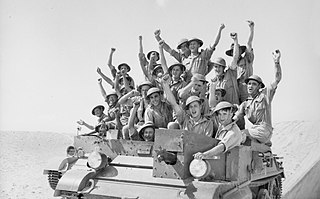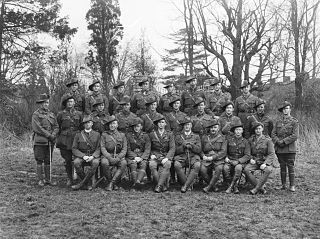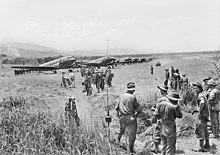Maroubra Force was the name given to the ad hoc Australian infantry force that defended Port Moresby, Papua New Guinea from the Japanese, and was involved in the Kokoda Track Campaign of the Pacific War, World War II. The force was established by the Allies under the codename "Maroubra", referring to the troops in the forward area, it was one of many units forming the body of the New Guinea Force, the main Allied army formation in the South West Pacific Area during 1942.

The 2/25th Battalion was an infantry battalion of the Australian Army which served during the Second World War. Raised in 1940, from volunteers drawn primarily from the state of Queensland, after completing its training the battalion undertook garrison duties in Darwin before deploying to the Middle East in mid-1941, as part of the 24th Brigade. There, it took part in more garrison duties in the Western Desert and in Palestine before it was reassigned from the 9th Division to the 7th Division and subsequently committed to the Syria–Lebanon campaign against the Vichy French. In early 1942, the 2/25th was returned to Australia to fight against the Japanese. Following this it took part in the fighting in New Guinea, undertaking two deployments there, firstly in 1942–1943 during which it took part the fighting along the Kokoda Track and around Buna–Gona, and then again in 1943–1944 when it helped to secure Lae before advancing into Finisterre Ranges. The battalion's final involvement in the war came in mid-1945, when it took part in the Borneo campaign, landing at Balikpapan. The battalion was disbanded in early 1946.

The 2/1st Battalion was an infantry battalion of the Australian Army. Formed as part of the Second Australian Imperial Force at the start of World War II, the battalion was deployed to the Middle East in early 1940 and subsequently took part in the early fighting in the North African campaign, taking part in battles around Bardia and Tobruk before later being sent to Greece in early 1941. A lightning German advance quickly pushed the Allies back and forced them to evacuate after a very short campaign and the 2/1st was landed on Crete where they subsequently fought unsuccessfully to repel a German invasion in May. The majority of the battalion was captured on Crete, but the 2/1st was subsequently re-built from survivors in Palestine and returned to Australia in early 1942 following Japan's entry into the war. They then fought two campaigns against the Japanese in New Guinea, fighting in the Kokoda Track campaign during 1942–43 and the Aitape–Wewak campaign in 1944–45. Following the war, the 2/1st was disbanded.

The 2/2nd Battalion was an infantry battalion of the Australian Army raised for service as part of the all-volunteer Second Australian Imperial Force during World War II. Raised in October 1939, the battalion was deployed to the Middle East and in early 1941 took part in the first ground action undertaken by Australian troops during the war during the Battle of Bardia before helping to capture Tobruk. In April, the battalion briefly fought in Greece, before being evacuated after the Allied forces were overwhelmed by German forces. Some members of the battalion took part in the Battle of Crete, after which the battalion undertook garrison duties in Syria. In mid-1942, the 2/2nd undertook defensive duties in Ceylon before returning to Australia. They subsequently took part in the fighting against the Japanese along the Kokoda Track and then around Buna–Gona. After a period of reorganisation and training in Australia throughout 1943–44, late in the war the battalion was committed to the Aitape–Wewak campaign before being disbanded in early 1946 after the war.

The 2/3rd Battalion was an infantry battalion of the Australian Army. Raised for service during the Second World War as part of the Second Australian Imperial Force, it was formed in October 1939 in Sydney and was attached to the 16th Brigade, 6th Division, the first formation raised as part of the 2nd AIF during the war. Deploying to the Middle East in early 1940, it saw action in North Africa, Greece, Crete, and Syria in 1941–1942 before returning to Australia following Japan's entry into the war, and was one of only two Australian infantry battalions to fight against all the major Axis powers of the war: the Germans, Italians, Japanese and Vichy French.

The 2/7th Battalion was an infantry battalion of the Australian Army raised for service during World War II. Formed as part of the 6th Division shortly after the outbreak of the war as part of the all-volunteer Second Australian Imperial Force, the 2/7th Battalion's initial personnel were recruited primarily from the state of Victoria, although later reinforcements were drawn from most other Australian states. Basic training was completed in Australia, after which the battalion embarked for the Middle East as part of the first batch of Australian troops to deploy overseas. Further training was undertaken in Palestine before the battalion went into action against the Italians in January 1941. After participating in the successful capture of Bardia and Tobruk, it was committed to the disastrous Battles of Greece and Crete, where the battalion was essentially destroyed after the majority of its personnel were captured.

The 39th Battalion was an infantry unit of the Australian Army. It was originally raised in February 1916 for service during World War I as part of First Australian Imperial Force, with personnel being drawn mainly from the state of Victoria. Making up part of the 10th Brigade, it was attached to the 3rd Division and served on the Western Front in France and Belgium before being disbanded in March 1919. Following the re-organisation of the Australian Army in 1921, the battalion was raised again in Victoria as a unit of the Citizens Force, becoming known as the "Hawthorn–Kew Regiment". In 1937, it was amalgamated with the 37th Battalion to become the 37th/39th Battalion. Later, in August 1939 it was delinked with the 37th and amalgamated with the 24th Battalion to form the 24th/39th Battalion, before being raised again as a single unit in October 1941.

The 3rd Battalion was an infantry battalion of the Australian Army. Originally raised as part of the First Australian Imperial Force for service during World War I, the battalion formed part of the 1st Brigade, attached to the 1st Division. It was formed shortly after the war broke out and was among the first Australian units to be sent overseas, arriving in Egypt in December 1914. In April 1915 the battalion participated in the Landing at Anzac Cove, coming ashore in the second and third waves. In December 1915 the 3rd Battalion was evacuated from the Gallipoli peninsula and withdrawn to Egypt again, where it took part in the defence of the Suez Canal before being sent to France to fight on the Western Front in March 1916. For the next two and a half years the unit would serve in the trenches in France and Belgium and would take part in many of the major battles fought during that time. In May 1919, following the end of the war, the battalion was disbanded and its personnel repatriated back to Australia.

The 2/10th Battalion was an infantry battalion of the Australian Army that was raised for overseas service as part of the all-volunteer Second Australian Imperial Force during World War II. Formed in October 1939, it was the first 2nd AIF unit raised from the state of South Australia during the war; after completing a period of training in Australia, the battalion embarked for overseas service. Initially, it had been intended that the 2/10th and its parent brigade – the 18th Brigade – would be sent to the Middle East to join the other brigades of the 6th Division, but instead the 18th Brigade was sent to strengthen the garrison in the United Kingdom after France capitulated in mid-1940. Re-assigned to the 9th Division, the 2/10th remained in the United Kingdom undertaking defensive duties until late 1940 when it finally arrived in the Middle East, where the 18th Brigade became part of the 7th Division.

New Guinea Force was a military command unit for Australian, United States and native troops from the Territories of Papua and New Guinea serving in the New Guinea campaign during World War II. Formed in April 1942, when the Australian First Army was formed from the Australian I Corps after it returned from the Middle East, it was responsible for planning and directing all operations within the territory up until October 1944. General Headquarters Southwest Pacific Area Operational Instruction No.7 of 25 May 1942, issued by Commander-Allied-Forces, General Douglas MacArthur, placed all Australian and US Army, Air Force and Navy Forces in the Port Moresby Area under the control of New Guinea Force. Over the course of its existence, New Guinea Force was commanded by some of the Australian Army's most notable commanders, including Sydney Rowell, Sir Edmund Herring and Sir Leslie Morshead.

The 2/9th Battalion was an infantry battalion of the Australian Army during World War II. Raised in Queensland as part of the Second Australian Imperial Force shortly after the outbreak of the war, it formed part of the 18th Brigade and over the course of the war it was attached to the 6th, 9th and 7th Divisions due to several re-organisations. It served in the United Kingdom in 1940, forming part of a small Australian garrison sent there to help defend against a possible German invasion, before being transferred to North Africa where it took part in the Siege of Tobruk and then undertook garrison duties in Syria following the Syria–Lebanon campaign in 1941.

The 2/31st Battalion was an infantry battalion of the Australian Army that served during World War II. It was raised in June 1940 and was assigned to the 25th Brigade, 7th Division. It initially served in the United Kingdom where it undertook defensive duties before being moved to the Middle East in 1941. After taking part in the fighting in Syria and Lebanon, the battalion undertook garrison duties around Tripoli before being transferred back to Australia in 1942. In late 1942 the battalion was sent to New Guinea to fight against the Japanese along the Kokoda Track. They subsequently fought a number of battles throughout 1942, 1943 and early 1944. Their last campaign came in mid-1945 when they landed on Borneo. After the war the battalion was disbanded in March 1946.

The 25th Brigade was a brigade-sized infantry unit of the Australian Army that served during the Second World War. Raised in July 1940 and consisting of three infantry battalions, the 25th Brigade initially served in the United Kingdom, where it formed part of the garrison tasked with defending against a possible German invasion. In 1941, the brigade was redeployed to the Middle East where it took part in the Syria–Lebanon campaign fighting several actions around Merdjayoun and Jezzine.

The 2/12th Battalion was an infantry battalion of the Australian Army which served during World War II. Raised in late 1939 as part of the all volunteer Second Australian Imperial Force, the battalion's initial recruits were drawn primarily from the states of Queensland and Tasmania. Assigned to the 18th Brigade, the battalion completed basic training in Australia before embarking for overseas in May 1940.

The 21st Brigade was a brigade-sized infantry unit of the Australian Army. It was briefly raised in 1912 as a Militia formation providing training as part of the compulsory training scheme. Later, it was re-formed in April 1940 as part of the Second Australian Imperial Force, the unit was raised for service during World War II. As part of the 7th Division the brigade's constituent units were raised from volunteers from several Australian states. After rudimentary training in Australia, the brigade deployed for the Middle East in October 1940. Defensive duties were mounted along the Libyan border in early 1941, before the brigade was committed to the Syria-Lebanon campaign, fighting against Vichy French forces. In early 1942, following Japan's entry into the war, the brigade returned to Australia. After a period of defensive duties in Australia, it was deployed to New Guinea and subsequently played a key role in the Kokoda Track campaign, delaying the Japanese advance towards Port Moresby and then joining the pursuit as the Japanese withdrew towards Buna–Gona. In 1943–1944, the brigade took part in the capture of Lae and the Ramu Valley–Finisterre Range campaign. Its final campaign of the war, came in the final months when it took part in the Balikpapan landings. It was disbanded in 1946.

The Invasion of Buna–Gona, called Operation RI by the Japanese, was a military operation by Imperial Japanese forces to occupy the Buna–Gona area in the Territory of Papua during the Pacific campaign of the Second World War. The initial landings and advance on Kokoda occurred between 21 and 27 July 1942. The Japanese invaded and occupied the location in preparation for an overland attack on Port Moresby along the Kokoda Track. The landing marked the start of the Kokoda Track campaign. The landings were not directly opposed by land forces but were engaged by elements of Maroubra Force as they advanced on Kokoda. This initially included B Company of the 39th Battalion, patrols of the Papuan Infantry Battalion (PIB) operating in the area and a small number of the Australian New Guinea Administrative Unit (ANGAU) that became attached to the force. The Australians were initially repulsed near Oivi but subsequently regrouped to defend Kokoda in an initial battle there from 28–29 July.

The 2/14th Battalion was an infantry battalion of the Australian Army that served during World War II. Part of the 21st Brigade, 7th Division, the battalion was raised from Second Australian Imperial Force volunteers drawn mainly from the state of Victoria. After completing training in Australia in 1940, the battalion deployed to the Middle East where it was stationed in Egypt and Palestine before it saw action against the Vichy French in Syria in June and July 1941, in a short lived campaign. Garrison duties in Lebanon followed before the battalion was withdrawn to Australia in early 1942 as Australian forces were concentrated in the Pacific to respond to the threat posed by Japan's entry into the war.

The 144th Infantry Regiment was an infantry regiment in the Imperial Japanese Army. The regiment was attached to the 55th Division. The regiment participated in the Second Sino-Japanese War and World War II, fighting in the Pacific during a number of battles including those at Guam, Rabaul, and Salamaua. It also participated in the invasion of Buna-Gona, the Kokoda Track campaign and the battle of Buna–Gona.

The 2/33rd Battalion was an infantry battalion of the Australian Army during the Second World War. It was formed as part of the Second Australian Imperial Force in the United Kingdom in June 1940 as the "72nd Battalion" to create the 25th Brigade, which eventually became part of the 7th Division. After the threat of invasion had passed, the battalion was transferred to the Middle East in early 1941, and after a period of garrison duty in the Western Desert, the battalion fought against the Vichy French in the invasion of Syria and Lebanon.

The 2/27th Battalion was an infantry battalion of the Australian Army during World War II. Raised in May 1940 as part of the 7th Division from volunteers from the state of South Australia, the battalion was assigned to the 21st Brigade. After completing training in Australia, the 2/27th deployed to the Middle East in November 1940, and in early 1941 undertook defensive duties in the Western Desert. The battalion's first combat experience came against the Vichy French during the short Syria–Lebanon campaign during which it fought major engagements around Sidon and Damour. At the conclusion of the fighting in Syria, the battalion remained in the area as part of the Allied occupation force until early 1942 when it was returned to Australia to fight against the Japanese.





















